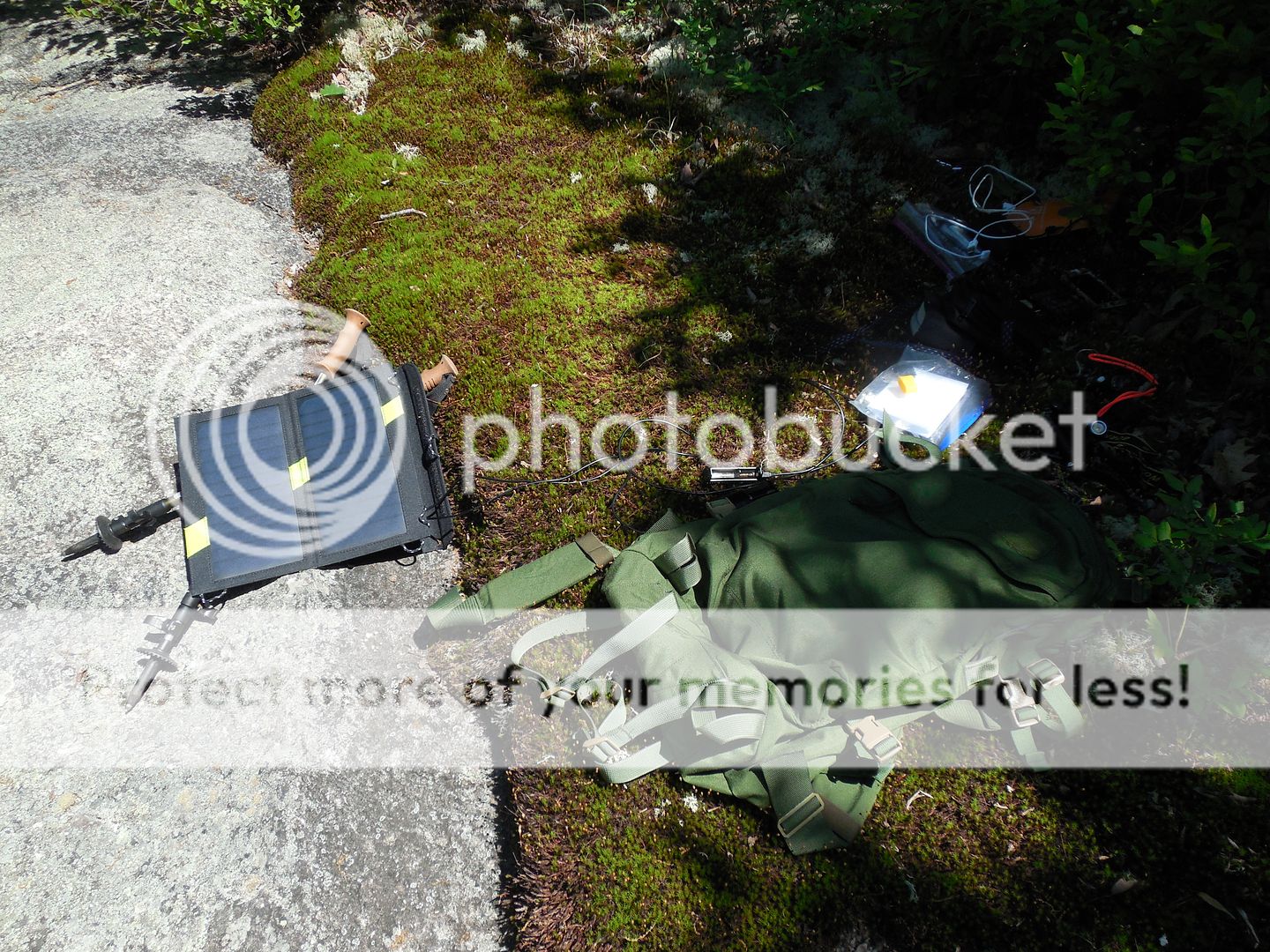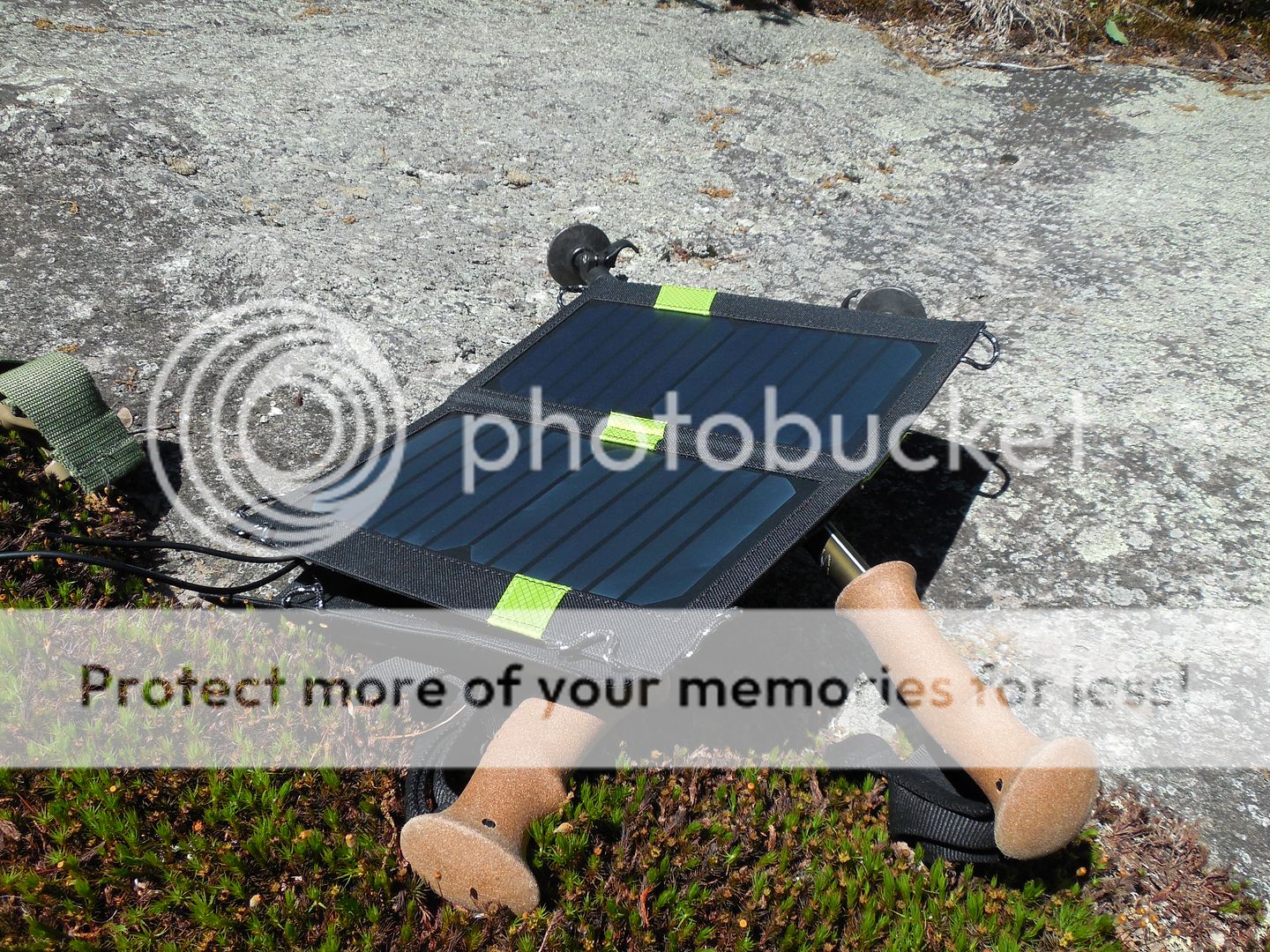Woods Walker
The Wood is cut, The Bacon is cooked, Now it’s tim
Here is my review of the Nitecore F1 Flexbank Charger. A very flexible charger for outdoors use. There is a little background story to this review. Some time ago I purchased another USB powered lithium ion charger from Nitecore, the UM10. It's a fine little charger though does lack of few options I wanted for outdoors and preparedness applications. First it couldn't act as a power bank aka use the charged battery to charge something else. I knew this when buying the UM10 so wasn't disappointed but still wished for the option. Secondly though it could charge via solar it wasn't fully solar compatible. If there was a solid interruption in power the UM10 like many other chargers would trigger an error requiring it to be plugged back in. Given the potential for clouds etc this meant the UM10 would need to be watched like a hawk when charging via solar. That said Nitecore never claimed it was solar compatible so again not disappointed rather wished for the ability. I still use the UM10 for home charging lithium ion batteries and recommend it.
Moving along some weeks ago Nitecore contacted me for an opportunity to review a new single battery charger geared towards my life style which is very mobile and in the woods. One of my long time wishes is to have control over power in the back country. This new charger appeared to offer me a solution so jumped at the chance to review it. In keeping with the mobile outdoors theme of this gear item most of this review will be done using solar power from my pack away from people and plugs.
So lets go!
Heading up the mountain. We have sun so there should be plenty of power!

A wild strawberry. It was rather good. Remember don't eat anything in the wild unless you know the identification however this one is kinda obvious. Still be careful out there.

Mountain laurels are in full bloom.



Solar power! The F1 charger never triggered a charging error during my testing despite my attempts to induce that. The F1 appears solar compatible!


Now that we are setup here is some information about the F1 Flexible charger from the Nitecore site.
http://charger.nitecore.com/product/f1
So how do the stats stack up under field use and evaluation? First let's take a look at the F1.
It comes with the charger and 2 wide rubber bands to secure the battery. As only one is needed guessing the extra is a backup. I use the yellow band to increase visibility.

Size comparison to a Nitecore NL189 18650.

Compared to a Nitecore UM10 Lithium ion charger.

Both compared to a 1XCR123 Armytek C1 Pro.

Information from the device is transmitted via 3 green LED light lights.

The first thing the F1 shows is the voltage of the Lithium Ion battery. Nitecore states:
I found the following:
1 indicator light and 3.5 volts (first 3 then second 5 blinks) = 30%
3 indicator lights and 4.2 volts (first 4 then second 2 blinks) = 100%
1 indicator light and 3.4 volts (first 3 then second 4 blinks) = 17%
3 indicator lights and 4 volts (first 4 blinks)= 95%
Seemed accurate enough for field use IMHO.
That appear to be the case.
I have seen flashing for low battery warning and had the F1 terminate charging. I forgot if the warning is one or 3 lights but doesn't matter as got my warning and it gets cranky around 3.3 volts. As for number 2 that's a bit in the air. It would always flash the 3 LED lights as a warning when a smaller capacity lithium ion is inserted but not always terminate the charging. Sometimes it does terminate the charge, other times it appears to trickle charge at such a slow rate as to make using 16340 and 14500 Lithium ion batteries as power banks impractical.

So yes it won't use them for the power bank function as stated but not always in the exact way as stated based on my field use. The F1 had no issues charging any of the Lithium ion batteries tested including 16340 and 14500. Was able to use 2600 and 3400 mAh 18650 and 2500 mAh 16650 as a power banks in addition to charging them.
Yes. I tested the goober insurance and it works. I can't be trusted with out polarity protection aka putting the battery in a@@ backwards so glad it has that protection.
Yes that appears to be the case based on my solar testing. Pass through charging actually works. Both the battery and devices got charged simultaneously via solar.


Micro for the external power in this case solar and standard USB for outgoing power.

I did test an Iphone 4s and protected 18650 battery using a high efficiency 14 watt Allpowers folding solar panel charger from 10:25 am to 12 PM. The phone and battery were connected via pass through with a single USB port. At 10:25 am the 18650 was 3.7 volts, phone 59%. At 12 PM the 18650 was 4.1 volts, phone 91%.
I am not so sure about that if my interpretation of what's written is correct. Seemed to charge without a battery so long as connected to power. Maybe it was slower but again hard to say. No reason to do it anyways.

Field use applications.
With the BIG power of 18650 batteries and the devices using them it's not hard to see the attraction of using them within outdoors and preparedness applications. For example I put the charged 18650 battery into my Nitecore HC30 headlamp.

But it can also work as a power bank for my phone in the field.


It also charged my Ipad from dead to 35% which is about right for a 3400 mAh battery.


The pass through charging capability is great for times when only one plug is available which happens more often when on the fly. In the coffee shop before a night hike. I am using a public magnetic charging ring. This option is not sold for the F1 however did work just fine. Charging both the battery for the headlamp plus an Ipod 6 which is used to keep track of data like distance hiked etc etc etc. Or browsing the forums on their WiFi without sucking down the phone battery.

Pros and cons.
Pros.
1. For the most part it provides a great control over energy in the back country as I hoped.
2. Very ultra light and small.
3. With rubber band the battery is very secure.
4. Simple to use.
5. Inexpensive but seemed well made. I don't think this will just fall apart but time will tell.
6. The pass through charging is both useful and fun.
7. Acts as both a charger and power bank.
8. Solar compatible.
9. More options in field use. I can take the battery directly from my flashlight to charge the phone. I can use the extra batteries for the flashlight or headlamp to charge my phone. I can take the battery from the charger to power the flashlight or headlamp.
Cons.
1. With the batteries I tested sometimes not all the features operated 100% per the manual. Nothing which overly harmed the field use but a few inconsistencies such as the low capacity battery charge termination and low voltage cut off which worked but not always exactly the same way. For example it could terminate the charge around 3.3 rather than 2.8 volts and charge again if plugged back in for a time or maybe not. That said the features did work. It was always able to detect low capacity batteries. It didn't really use the low capacity batteries as a power bank and did actually cut off at low voltage. It generally put in the correct amount of charge for battery capacity when used as a power bank.
2. Didn't come with a USB cable but got so many already.
3. Without the rubber band it can easily toss the battery.
Conclusion.
It's a winner IMHO.
Here is a video of the evaluation and field testing.
Moving along some weeks ago Nitecore contacted me for an opportunity to review a new single battery charger geared towards my life style which is very mobile and in the woods. One of my long time wishes is to have control over power in the back country. This new charger appeared to offer me a solution so jumped at the chance to review it. In keeping with the mobile outdoors theme of this gear item most of this review will be done using solar power from my pack away from people and plugs.
So lets go!
Heading up the mountain. We have sun so there should be plenty of power!

A wild strawberry. It was rather good. Remember don't eat anything in the wild unless you know the identification however this one is kinda obvious. Still be careful out there.

Mountain laurels are in full bloom.



Solar power! The F1 charger never triggered a charging error during my testing despite my attempts to induce that. The F1 appears solar compatible!


Now that we are setup here is some information about the F1 Flexible charger from the Nitecore site.
http://charger.nitecore.com/product/f1
The F1 Flex is Nitecore's first outdoor battery charger. Lightweight and durable, this charger is a fantastic way to always have power at your fingertips - no matter how far you travel. Ideal for backpacking, this is the perfect charger for the rugged nature-lovers out there.
Features:
Compatible with cylinder rechargeable Li-ion batteries of various sizes
Intelligent USB charging management system
Up to 1000mA fast charging through Micro-USB input port
1000mA fast charging through USB output port
Optimized design for IMR battery charging circuit
Three power indicators to indicate charging/discharging status
Automatic power level detection
Instant battery voltage indication upon battery installation
Automatic battery detection and appropriate charging voltage/mode selection
Battery reversed polarity protection and short circuit prevention
Made from durable PC material (fire retardant/flame resistant)
Designed for optimal heat dissipation
Certified by RoHS, CE, FCC and CEC
Specifications:
Input : DC 5V, ≥500mA
Output voltage:
4.2V±1% (slot)/5V±5% (USB), 1000mA MAX (slot)/1000mA (USB)
Compatible with: Li-ion /IMR:
26650/18650/17670/18490/17500/17335/16340(RCR123)/14500/10440
Size: 3.43 inches × 0.94 inches × 1.15 inches (87.2mm×24mm×29.3mm)
Weight: 1.07oz (30.4g, without cord)
Content in package: F1 Outdoor charger x1, Rubber Band x2
So how do the stats stack up under field use and evaluation? First let's take a look at the F1.
It comes with the charger and 2 wide rubber bands to secure the battery. As only one is needed guessing the extra is a backup. I use the yellow band to increase visibility.

Size comparison to a Nitecore NL189 18650.

Compared to a Nitecore UM10 Lithium ion charger.

Both compared to a 1XCR123 Armytek C1 Pro.

Information from the device is transmitted via 3 green LED light lights.

The first thing the F1 shows is the voltage of the Lithium Ion battery. Nitecore states:
1. When a battery is installed inside F1's charging slot, its power indicators will blink to indicate the battery's
voltages. For example, when a 4.2V battery is installed, the top indicator blinks four times, followed by
two blinks from the indicator in the middle.
2. After voltage indication, the three indicators will blink to indicate battery power levels.
Three indicators on stand for power levels above 81%; Two indicators on stand for power levels between 41% and 80%; One indicator on stands for power levels between 1% and 40%
I found the following:
1 indicator light and 3.5 volts (first 3 then second 5 blinks) = 30%
3 indicator lights and 4.2 volts (first 4 then second 2 blinks) = 100%
1 indicator light and 3.4 volts (first 3 then second 4 blinks) = 17%
3 indicator lights and 4 volts (first 4 blinks)= 95%
Seemed accurate enough for field use IMHO.
Sleep Mode
If neither an external power source nor an external device is connected, F1 will enter sleep mode in 10
seconds upon battery installation. In this mode, F1 will resume normal functions once an external power
source and/or an external device is connected.
That appear to be the case.
1. During charging, the power indicators will indicate the power levels of the battery in the slot with blinks.
When power levels are below 3.3V, the three indicators will blink to alarm the user. When power levels
are below 2.8V, F1 terminates charging to protect the battery.
2. When F1 detects a small capacity battery (e.g. 16340, RCR123, 14500, 10440) in its slot, the three
indicators will blink to alarm the user and F1 terminates charging after five seconds to protect the battery.
I have seen flashing for low battery warning and had the F1 terminate charging. I forgot if the warning is one or 3 lights but doesn't matter as got my warning and it gets cranky around 3.3 volts. As for number 2 that's a bit in the air. It would always flash the 3 LED lights as a warning when a smaller capacity lithium ion is inserted but not always terminate the charging. Sometimes it does terminate the charge, other times it appears to trickle charge at such a slow rate as to make using 16340 and 14500 Lithium ion batteries as power banks impractical.

So yes it won't use them for the power bank function as stated but not always in the exact way as stated based on my field use. The F1 had no issues charging any of the Lithium ion batteries tested including 16340 and 14500. Was able to use 2600 and 3400 mAh 18650 and 2500 mAh 16650 as a power banks in addition to charging them.
·Battery reversed polarity protection and short circuit prevention
Yes. I tested the goober insurance and it works. I can't be trusted with out polarity protection aka putting the battery in a@@ backwards so glad it has that protection.
2. F1 features intelligent USB charging management system. Under sufficient input power, F1 can
simultaneously charge a battery in the slot and a connected external device (with 1000mA current). With
lower input power, F1 can charge the battery with 500mA current, and charge the external device with
1000mA current.
3. With the input power insufficient to support charging two items simultaneously, F1 will charge the battery
only with 500mA current. After battery charging completed, F1 will proceed to charge the connected
external device.
Yes that appears to be the case based on my solar testing. Pass through charging actually works. Both the battery and devices got charged simultaneously via solar.


Micro for the external power in this case solar and standard USB for outgoing power.

I did test an Iphone 4s and protected 18650 battery using a high efficiency 14 watt Allpowers folding solar panel charger from 10:25 am to 12 PM. The phone and battery were connected via pass through with a single USB port. At 10:25 am the 18650 was 3.7 volts, phone 59%. At 12 PM the 18650 was 4.1 volts, phone 91%.
1. A battery must be placed in the slot in order to charge an external device through USB.
I am not so sure about that if my interpretation of what's written is correct. Seemed to charge without a battery so long as connected to power. Maybe it was slower but again hard to say. No reason to do it anyways.

Field use applications.
With the BIG power of 18650 batteries and the devices using them it's not hard to see the attraction of using them within outdoors and preparedness applications. For example I put the charged 18650 battery into my Nitecore HC30 headlamp.

But it can also work as a power bank for my phone in the field.


It also charged my Ipad from dead to 35% which is about right for a 3400 mAh battery.


The pass through charging capability is great for times when only one plug is available which happens more often when on the fly. In the coffee shop before a night hike. I am using a public magnetic charging ring. This option is not sold for the F1 however did work just fine. Charging both the battery for the headlamp plus an Ipod 6 which is used to keep track of data like distance hiked etc etc etc. Or browsing the forums on their WiFi without sucking down the phone battery.

Pros and cons.
Pros.
1. For the most part it provides a great control over energy in the back country as I hoped.
2. Very ultra light and small.
3. With rubber band the battery is very secure.
4. Simple to use.
5. Inexpensive but seemed well made. I don't think this will just fall apart but time will tell.
6. The pass through charging is both useful and fun.
7. Acts as both a charger and power bank.
8. Solar compatible.
9. More options in field use. I can take the battery directly from my flashlight to charge the phone. I can use the extra batteries for the flashlight or headlamp to charge my phone. I can take the battery from the charger to power the flashlight or headlamp.
Cons.
1. With the batteries I tested sometimes not all the features operated 100% per the manual. Nothing which overly harmed the field use but a few inconsistencies such as the low capacity battery charge termination and low voltage cut off which worked but not always exactly the same way. For example it could terminate the charge around 3.3 rather than 2.8 volts and charge again if plugged back in for a time or maybe not. That said the features did work. It was always able to detect low capacity batteries. It didn't really use the low capacity batteries as a power bank and did actually cut off at low voltage. It generally put in the correct amount of charge for battery capacity when used as a power bank.
2. Didn't come with a USB cable but got so many already.
3. Without the rubber band it can easily toss the battery.
Conclusion.
It's a winner IMHO.
Here is a video of the evaluation and field testing.
Last edited:

